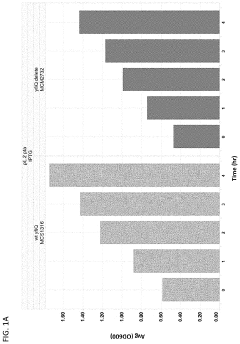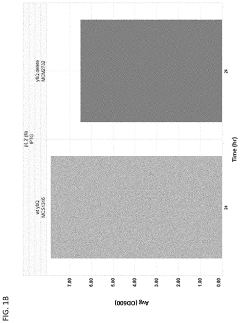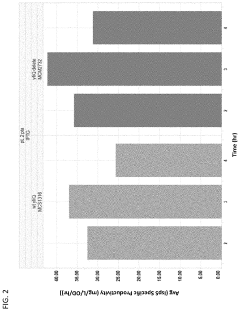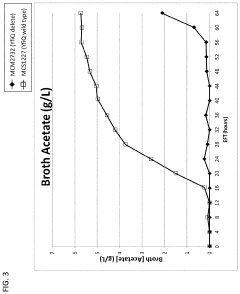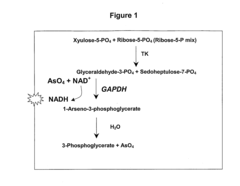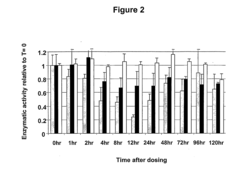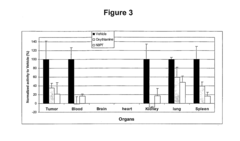Biochemical Investigations into Pentose Phosphate Pathway Variability
Research Background and Objectives
The pentose phosphate pathway (PPP) is a fundamental metabolic pathway in cellular biochemistry, playing a crucial role in carbohydrate metabolism and redox balance. This pathway, discovered in the 1950s, has been the subject of extensive research due to its significance in various biological processes. The PPP operates parallel to glycolysis and is essential for generating NADPH, ribose-5-phosphate, and other important metabolic intermediates.
The primary objectives of investigating pentose phosphate pathway variability are to understand the pathway's flexibility and adaptability across different organisms and cellular conditions. This research aims to elucidate how variations in PPP activity contribute to cellular homeostasis, stress response, and metabolic regulation. By exploring these variations, scientists seek to gain insights into the pathway's role in diverse physiological and pathological states.
One key aspect of PPP research is the examination of its two distinct phases: the oxidative and non-oxidative branches. The oxidative branch is responsible for NADPH production, which is critical for maintaining cellular redox balance and supporting biosynthetic processes. The non-oxidative branch, on the other hand, generates ribose-5-phosphate, a crucial component for nucleotide synthesis. Understanding the interplay between these branches and their variability under different conditions is a central focus of current investigations.
Recent technological advancements have significantly enhanced our ability to study PPP variability. High-throughput metabolomics, isotope tracing techniques, and advanced computational modeling have enabled researchers to track metabolic fluxes through the pathway with unprecedented precision. These tools allow for a more comprehensive analysis of how PPP activity fluctuates in response to various stimuli, including nutrient availability, oxidative stress, and cellular differentiation.
The study of PPP variability extends beyond basic biochemistry, with important implications for fields such as cancer research, immunology, and metabolic disorders. For instance, altered PPP activity has been observed in many cancer types, suggesting its potential as a therapeutic target. In immunology, the pathway's role in supporting rapid cell proliferation and antibody production highlights its importance in immune responses.
As research progresses, the objectives of PPP variability studies continue to evolve. Current goals include mapping the regulatory networks that control PPP flux, identifying novel enzymes or isoforms involved in the pathway, and understanding how PPP interacts with other metabolic pathways. Additionally, there is growing interest in exploring how environmental factors and genetic variations influence PPP activity across different species and cell types.
Market Analysis for PPP-Related Research
The market for research related to the Pentose Phosphate Pathway (PPP) has been experiencing significant growth in recent years, driven by the increasing importance of this metabolic pathway in various biological processes and its potential applications in biotechnology and medicine. The global market for PPP-related research is estimated to be expanding at a compound annual growth rate of over 6% from 2020 to 2025.
One of the primary drivers of this market growth is the rising interest in cancer research. The PPP plays a crucial role in cancer cell metabolism, providing essential building blocks for nucleotide synthesis and maintaining redox balance. As a result, pharmaceutical companies and research institutions are investing heavily in understanding PPP variability to develop novel cancer therapies and diagnostic tools.
Another significant factor contributing to market demand is the growing field of metabolic engineering. Biotechnology companies are exploring ways to manipulate the PPP to enhance the production of valuable compounds, such as biofuels, pharmaceuticals, and fine chemicals. This has led to increased funding for research projects focused on elucidating the regulatory mechanisms of the PPP and developing strategies to optimize its flux.
The agricultural sector is also showing interest in PPP-related research, particularly in improving crop yields and stress resistance. Studies on PPP variability in plants have revealed its importance in responding to environmental stresses, such as drought and oxidative stress. This has opened up new avenues for developing more resilient crop varieties, driving demand for research in this area.
In the healthcare industry, there is growing recognition of the PPP's role in neurodegenerative diseases and aging. Research into PPP variability is shedding light on the mechanisms underlying these conditions, potentially leading to new therapeutic approaches. This has attracted significant investment from both pharmaceutical companies and government funding agencies.
Geographically, North America and Europe currently dominate the market for PPP-related research, owing to their well-established research infrastructure and strong funding support. However, the Asia-Pacific region is expected to witness the fastest growth in the coming years, driven by increasing government investments in life sciences research and the rapid expansion of biotechnology industries in countries like China and India.
The market is characterized by a mix of academic institutions, biotechnology companies, and pharmaceutical firms. Collaborations between these entities are becoming increasingly common, fostering innovation and accelerating the translation of research findings into practical applications. This trend is expected to continue, further driving market growth and technological advancements in PPP-related research.
Current Challenges in Variability Studies of Pentose Phosphate Pathway
The study of Pentose Phosphate Pathway (PPP) variability presents several significant challenges that researchers must navigate. One of the primary obstacles is the inherent complexity of the pathway itself. The PPP is intricately connected to various other metabolic processes, making it difficult to isolate and study its variations without considering the broader metabolic context.
Methodological limitations pose another substantial challenge. Current techniques for measuring PPP flux and intermediates often lack the sensitivity and specificity required to capture subtle variations accurately. This is particularly problematic when studying minor fluctuations in pathway activity that may have significant biological implications.
The dynamic nature of PPP regulation adds another layer of complexity. The pathway's activity can rapidly change in response to cellular conditions, making it challenging to obtain consistent and representative measurements. This temporal variability necessitates the development of more sophisticated real-time monitoring techniques.
Genetic and environmental factors significantly influence PPP variability, creating a multifaceted landscape that researchers must decipher. Genetic polymorphisms in PPP enzymes can lead to functional variations, while environmental factors such as nutrient availability and oxidative stress can modulate pathway activity. Disentangling these various influences to understand their individual and combined effects on PPP variability remains a formidable task.
Inter-species differences in PPP regulation and function further complicate comparative studies. What holds true for one model organism may not necessarily apply to others, limiting the generalizability of findings and necessitating careful validation across multiple species.
The integration of PPP variability data with other -omics datasets presents both an opportunity and a challenge. While multi-omics approaches offer a more comprehensive view of cellular metabolism, they also introduce computational and interpretative complexities that researchers must overcome to extract meaningful insights.
Lastly, the translation of PPP variability findings from in vitro to in vivo systems remains a significant hurdle. Cell culture models may not fully recapitulate the complex physiological conditions that influence PPP activity in living organisms, necessitating the development of more sophisticated experimental models that bridge this gap.
Existing Methods for PPP Variability Analysis
01 Genetic engineering of pentose phosphate pathway
Genetic modification techniques are used to alter the pentose phosphate pathway in microorganisms. This involves manipulating genes related to key enzymes in the pathway to enhance or reduce their activity, potentially leading to improved production of desired compounds or increased metabolic efficiency.- Genetic engineering of pentose phosphate pathway: Genetic modification techniques are used to alter the pentose phosphate pathway in organisms. This involves manipulating genes related to key enzymes in the pathway to enhance or modify its function. Such modifications can lead to improved metabolic efficiency or the production of desired compounds.
- Metabolic flux analysis of pentose phosphate pathway: Techniques for analyzing the metabolic flux through the pentose phosphate pathway are developed. These methods involve measuring the flow of metabolites and intermediates through the pathway, allowing researchers to understand its variability under different conditions or in different organisms.
- Regulation of pentose phosphate pathway in disease states: Studies focus on how the pentose phosphate pathway is regulated in various disease states, including cancer and metabolic disorders. Understanding these regulatory mechanisms can lead to new therapeutic approaches targeting the pathway's variability.
- Pentose phosphate pathway in microbial fermentation: Research explores the role and variability of the pentose phosphate pathway in microbial fermentation processes. This includes studying how different microorganisms utilize the pathway and how it can be optimized for biotechnological applications, such as the production of biofuels or other valuable compounds.
- Computational modeling of pentose phosphate pathway: Development of computational models to simulate and predict the behavior of the pentose phosphate pathway under various conditions. These models help in understanding the pathway's variability and its interactions with other metabolic processes, aiding in the design of metabolic engineering strategies.
02 Metabolic flux analysis of pentose phosphate pathway
Researchers employ metabolic flux analysis techniques to study the variability in the pentose phosphate pathway. This involves tracking the flow of metabolites through the pathway using isotope labeling and advanced analytical methods, providing insights into how different conditions affect pathway activity and efficiency.Expand Specific Solutions03 Regulation of pentose phosphate pathway in cancer cells
Studies focus on understanding how the pentose phosphate pathway is regulated in cancer cells. This includes investigating the role of specific enzymes and metabolites in controlling pathway flux, as well as exploring potential therapeutic targets to modulate the pathway in cancer treatment.Expand Specific Solutions04 Pentose phosphate pathway in stress response
Research examines how the pentose phosphate pathway responds to various stress conditions, such as oxidative stress or nutrient limitation. This involves studying changes in enzyme activity, metabolite levels, and pathway flux under different environmental conditions to understand the pathway's role in cellular adaptation.Expand Specific Solutions05 Computational modeling of pentose phosphate pathway variability
Computational approaches are used to model and predict variability in the pentose phosphate pathway. These models incorporate various factors such as enzyme kinetics, metabolite concentrations, and regulatory mechanisms to simulate pathway behavior under different conditions and predict potential outcomes of genetic or environmental perturbations.Expand Specific Solutions
Key Institutions in Pentose Phosphate Pathway Biochemistry
The biochemical investigation into pentose phosphate pathway variability is in a mature research phase, with significant market potential in pharmaceutical and biotechnology sectors. The global market for related technologies is expanding, driven by increasing demand for metabolic engineering and drug development applications. Technologically, the field is well-established but still evolving, with companies like BASF SE, Bayer Pharma AG, and Novozymes A/S leading in innovation. Academic institutions such as The Regents of the University of California and Centre National de la Recherche Scientifique contribute significantly to fundamental research. The competitive landscape is diverse, with both large corporations and specialized biotech firms like AVEO Pharmaceuticals, Inc. and Evonik Operations GmbH actively participating in research and development efforts.
Ajinomoto Co., Inc.
BASF SE
Innovative Approaches in PPP Investigations
- Modulating the expression and activity of acetylating proteins in recombinant microorganisms to increase the production of mevalonate, isoprene, isoprenoid precursors, and acetyl-CoA-derived products through genetic engineering, specifically by using nucleic acids encoding acetylating proteins, MVA pathway enzymes, and isoprene synthase, thereby enhancing carbon flux towards mevalonate production.
- A fluorescence-based assay that measures the enzymatic activities of these enzymes in cell lysates, tissues, and blood, providing increased sensitivity and convenience by eliminating the need for enzyme isolation and reducing sample manipulation, allowing for high-throughput analysis.
Metabolomics Integration in Pentose Phosphate Pathway Studies
The integration of metabolomics in Pentose Phosphate Pathway (PPP) studies has revolutionized our understanding of this crucial metabolic pathway's variability. Metabolomics, the comprehensive analysis of small molecule metabolites, provides a powerful tool for investigating the dynamic nature of PPP across different biological systems and conditions.
One of the key advantages of metabolomics in PPP studies is its ability to capture the pathway's flux in real-time. By measuring the concentrations of intermediates and end-products, researchers can gain insights into the rate-limiting steps and regulatory mechanisms governing PPP activity. This approach has revealed unexpected variations in PPP flux between different cell types, tissues, and organisms, challenging previously held assumptions about the pathway's uniformity.
Metabolomics has also enabled the discovery of novel PPP intermediates and branch points. For instance, recent studies utilizing high-resolution mass spectrometry have identified previously unknown metabolites that participate in PPP-related reactions. These findings have expanded our understanding of the pathway's complexity and its interactions with other metabolic networks.
The integration of metabolomics with other omics technologies, such as transcriptomics and proteomics, has further enhanced our ability to investigate PPP variability. Multi-omics approaches allow researchers to correlate changes in metabolite levels with alterations in gene expression and enzyme activity, providing a more comprehensive view of PPP regulation at multiple levels of biological organization.
Advances in metabolomics techniques have also improved our capacity to study PPP variability in response to environmental factors and disease states. For example, stable isotope-resolved metabolomics has been employed to track the fate of glucose through the PPP under different conditions, revealing how factors such as oxidative stress and nutrient availability modulate pathway activity.
The application of metabolomics in PPP studies has significant implications for understanding metabolic disorders and developing targeted therapies. By identifying specific metabolic signatures associated with PPP dysregulation, researchers can potentially develop biomarkers for early disease detection and monitor treatment efficacy. Moreover, metabolomics-driven insights into PPP variability are informing the design of novel therapeutic strategies aimed at modulating pathway activity in various pathological conditions.
Ethical Considerations in Biochemical Research
Ethical considerations play a crucial role in biochemical research, particularly in studies involving the pentose phosphate pathway variability. As researchers delve into the intricacies of this metabolic pathway, they must navigate a complex landscape of ethical challenges to ensure the integrity and responsible conduct of their investigations.
One primary ethical concern is the use of human subjects or animal models in pentose phosphate pathway research. Investigators must adhere to strict protocols for informed consent when working with human participants, ensuring that individuals fully understand the nature of the study, potential risks, and benefits. For animal studies, researchers are obligated to minimize suffering and employ the principles of the 3Rs: Replacement, Reduction, and Refinement.
Data integrity and transparency are paramount in biochemical investigations. Researchers must maintain meticulous records of their methodologies, results, and analyses. Any conflicts of interest should be disclosed, and negative results should be reported alongside positive findings to prevent publication bias and ensure a comprehensive understanding of the pentose phosphate pathway's variability.
The potential implications of pentose phosphate pathway research on human health and disease treatment raise additional ethical considerations. Researchers must carefully weigh the potential benefits of their work against any risks, particularly when investigating genetic variations that may impact an individual's susceptibility to certain diseases or response to treatments.
Confidentiality and privacy concerns are also significant, especially when dealing with genetic information related to pentose phosphate pathway variability. Researchers must implement robust data protection measures to safeguard sensitive information and respect the privacy rights of study participants.
Collaboration and data sharing in the scientific community present both opportunities and ethical challenges. While open science practices can accelerate progress in understanding pentose phosphate pathway variability, researchers must navigate issues of intellectual property rights, authorship, and fair attribution of contributions.
Ethical considerations extend to the potential environmental impact of biochemical research. Investigators should strive to minimize waste and implement sustainable laboratory practices when conducting experiments related to the pentose phosphate pathway.
Lastly, researchers must be mindful of the potential dual-use nature of their findings. While advances in understanding pentose phosphate pathway variability may lead to beneficial medical applications, this knowledge could potentially be misused. Scientists have an ethical obligation to consider the broader implications of their work and take appropriate measures to prevent misuse of their research.
